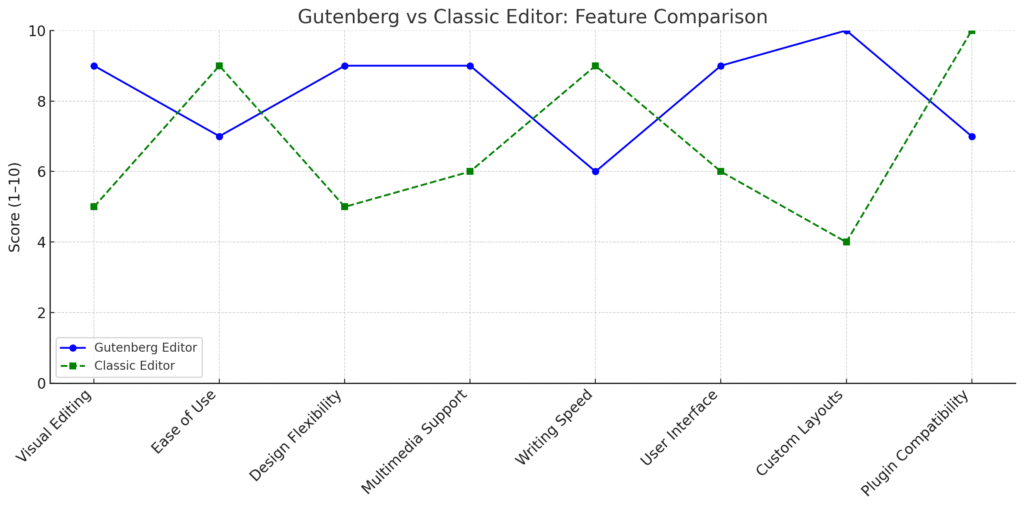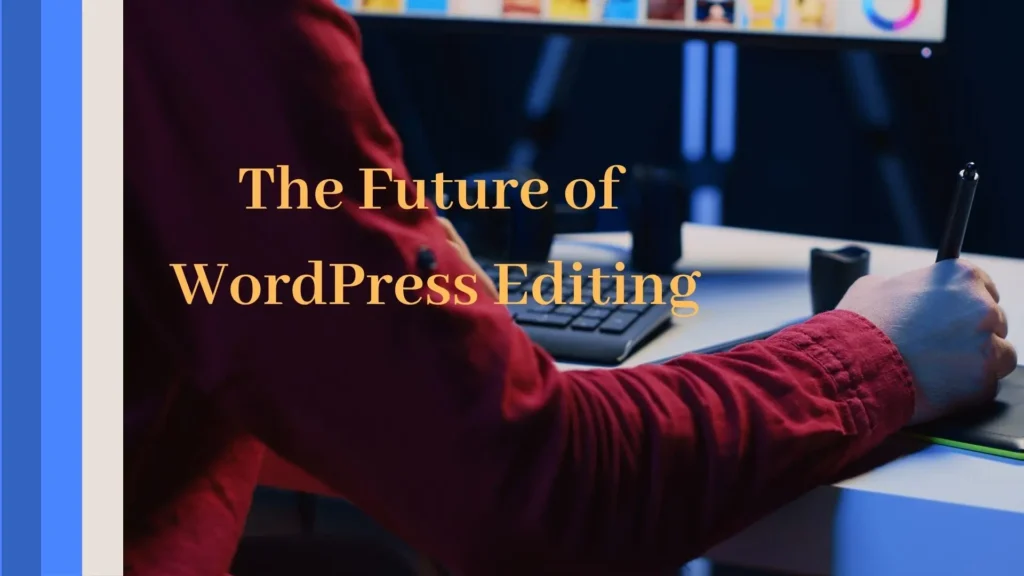The newer editing introduced by WordPress in 2018 is Gutenberg. It is also the Block Editor, as you have an opportunity to create content with the help of blocks. Every one of the blocks is a piece of content e.g. paragraph, image, video, heading, or button.
A little example: you have to write a blog post and you need to add an image, all you do is to add an image block and insert your picture. In case you want to include a quotation you insert a quote block. In such a a manner, you will be able to create your piece of content element by element.
Gutenberg has the aim of making editing more visual and flexible. It is made in such a way that it enables the user to have a greater control without information on any code.
What is the Classic Editor?
The older WordPress editor is the Classic Editor, used before the Gutenberg was released. It resembles more of a classic text editor, like Microsoft word. You write your content within a huge white box, upload images through a button and you format your text through a toolbar on the top.
The Classic Editor is easier and very simple to use. It is block free. It is all in one large editor field. Even those people, who have been using WordPress long enough, tend to use the Classic Editor as they are more accustomed to the editor.
Editing Style Differences
Gutenberg also brings in a more contemporary mode of editing courtesy of its block based structure. Every chunk of your work is put in a separate block, where you can easily move the blocks or edit only which one of them. This implies that you are able to position a block of text with respect to an image or develop layouts that appear to be more ‘professionally done’.
Whereas, the Classic Editor considers your whole post or page as a single large text document. You are doing it in one editing area where you write and handle everything at once. This system is quicker or plain text writing, and it lacks a lot of flexibility when it comes to the layout or design. Visual modifications will require additional plugins or even custom HTML code in the vast majority of cases.
User Interface Comparison
Gutenberg has a contemporary dynamic user interface. It has sidebars, block toolbars and icons that assist you to know the functionality of each block. Once you place a click on any block; it will display certain block settings and options to the right side of the block. This enables you to preview your work on the fly and watch changes accordingly on the site.
The Classic Editor, on the contrary, provides a simple and clean interface. At the bottom you observe a great text box and a toolbar with the buttons of formatting. All the options are on a single screen and have no side panels or block settings. This simplicity may be reassuring to people who are new to writing and publishing and are not interested in any additional functionality and design tools.

Content Flexibility
Gutenberg offers you so much freedom of design contrasted to using the Classic Editor. It is possible to make buttons, columns, table, and even insert videos and tweets; you do not need to install additional plug-ins. This allows designing professional-looking pages which are visually appealing. You may also add special blocks such as testimonials, product presentations, and custom layout in a few clicks.

Conversely, the Classic Editor is less flexible in respect to design. Writing and formatting a text, adding photos and using short codes do not present any problem when one knows how to do it, however, more complicated, creative layouts are achieved with help of extra tools. To create a page containing several sections or interactive features, it is probably necessary to use one of the page builder tools or come up with the code in HTML and CSS.
Ease of Use
Classic Editor tends to be easier to learn by people who are completely new to WordPress. It is simple and has basic features that are suitable and easy to write a blog post. It has fewer buttons, fewer features and it all happens in one place, something which can be less confusing to the beginner.
Gutenberg, which is also created to be user-friendly, may seem a bit complicated initially. As every piece of the content is done by means of blocks, you need some time to adapt to working with blocks, moving blocks, and their settings. Nonetheless, after getting used to it, Gutenberg can even be more versatile and quick, particularly when multimedia or fancy layouts are involved.
Writing Speed
The Classic Editor tends to be faster when you want to write long articles or postings using few visuals or design. It is easy to initiate typing, style your text and post. No blocks to set and no settings.
Gutenberg could slightly slow you down in case you have to write a large piece of text and switch as well as edit each block. But in the cases where you put lots of different things together such as quotes, videos, images and buttons, Gutenberg can literally accelerate some things because it has everything you need in the editor to begin with.
Gutenberg Features in Detail
The Gutenberg Block system is the most significant attribute found in Gutenberg. Each of your created contents comes out as the development of a certain kind of block. It consists of the paragraphs, headings, pictures, videos, buttons, columns etc. You can move these blocks wherever you like so that; it fits into the layout that you desire. In case you use the same design of the block a lot of times, you may save this block as a reusable block that you can use later in different pages.
Drag-and-drop is also a useful aspect because it enables moving around the page with blocks. It also has the live preview option, and you can get a sight of how it will be published before publication. Gutenberg also covers a vast selection of media which allows you to add a gallery of images, paste the YouTube video or include an audio clip with a few clicks.
Features of the Classic Editor
The Classic Editor is speed and simple-minded. It provides simplified writing in style with a text formatting toolbar like a word processor. Media files may be added with the use of the assortment media option at the top and the opportunity to switch to a visual version and a text (HTML) version to be able to do more in-depth editing.
This editor is compatible with older WordPress plugins and themes that have not figured out support of Gutenberg yet. It also helps with short codes, i.e. minor pieces of code, which you can employ in order to add special features, e.g. contact forms or sliders. The Classic Editor should continue to be an option as it is easy to use and familiar with its tools to those users that simply want an editor to type and share.
Choosing the Right Editor
You should conclude which of Gutenberg and the Classic Editor to use based on your needs.
- The Classic Editor can be more suitable to those who simply write simple posts and want to experience it fast and clean.
- It will give you the freedom to concentrate on what you are writing.
- Nevertheless, in case you want to design more stunning pages with pictures, videos, buttons, and various designs, Gutenberg is most probably the right choice.
- It provides you with more flexibility in how your content appears and acts; although it is more time-consuming to pick up.
Switching Between Editors
That, in fact, is one of the most brilliant aspects about the WordPress, you are not limited by a single editor.
On the one hand, Gutenberg It happens that you begin with Gutenberg and decide that you like the old style more, you can then install the Classic Editor plugin and flip back. In the same measure, when updating Gutenberg, you do not want to continue using it anymore or should you choose to use it, you will make the plugin inactive and resume using the block editor.
The best WordPress themes and plugins even allow you to select the editor to use in each individual post or page.
The Future of WordPress Editing
The next stop of WordPress is Gutenberg. It is in the works to support full site editing and this means that in the future you will be able to design not just your posts and pages, but your headers, footers and sidebars with the blocks too. This is why Gutenberg is a device that will also expand and get better in the course of time.

Nevertheless, WordPress has assured that it will continue to support Classic Editor plugin up to the year 2026. It implies that in case you like the old style, you may continue working with it without fearing to lose any access or support.
Conclusion
Both Gutenberg and the Classic Editor are quite useful to develop content in WordPress. Gutenberg is fresh, pictorial and targets the individuals, whose intention is on having greater control of layout and design. The Classic Editor is easier, quick, and common mostly to those who have long used WordPress. You can adopt the one that suits you depending on your objectives and feel free to do. The best part is that you are also free to use both and see which is going to work better with you.
FAQ’s
It may seem more difficult initially but after acquiring an understanding of how blocks work, it becomes easier and, at the same time, more potent.
Yes. All it takes is the installation of the Classic Editor plugin, and you will be back to the former interface.
No. Gutenberg enables you to make layouts without any coding through blocks.
In case you have a text-oriented blog, the Classic Editor will suffice. Gutenberg is superior to blogs that have media





